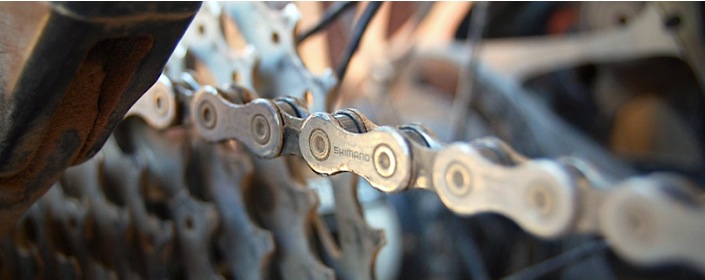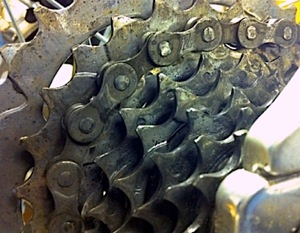
Checking your chain for wear is a much neglected part of regular bicycle maintenance. In fact, many people are unaware that a bicycle chain is a consumable part just like tires or brake pads.
What is chain stretch?
Contrary to popular belief the chain isn't actually stretching at all; it is the pins holding the links together that wear and elongate, effectively lengthening the pitch of the chain. The holes in the inner and outer link plates, through which this pin sits, also enlarge over time.
There are many factors which may contribute to the time or distance it takes to wear a chain out. Riding in adverse conditions like rain, snow or mud and then neglecting to clean the chain could potentially speed up the wear process. Perhaps motivation to keep your bike clean is the money you will save in reducing the frequency of replacing drivetrain parts!
Why is it a problem?
 The reality is that on a cheaper bike you could ride a worn-out, stretched chain for years and not even know it. I've seen some shockers in my time in the bike shop that simply were not economical to repair. It is a different story on a more expensive performance bike, where efficient running requires the smooth meshing of chain and cogs. When you ride a finely-tuned bike you become accustomed to it humming along without clicking, clanking or creating various metallic rubbing sounds.
The reality is that on a cheaper bike you could ride a worn-out, stretched chain for years and not even know it. I've seen some shockers in my time in the bike shop that simply were not economical to repair. It is a different story on a more expensive performance bike, where efficient running requires the smooth meshing of chain and cogs. When you ride a finely-tuned bike you become accustomed to it humming along without clicking, clanking or creating various metallic rubbing sounds.
Worn chains do not mesh well with cassette and chainring cogs and as a result you may experience gear "slippage". The worn pins are more liable to snap under pedalling pressure and lastly, a stretched chain eventually wears out your cassette and potentially your chainrings as well. A $30 chain replacement could become a $150 disaster! (This is a minimum.... If you ride Shimano Dura Ace, SRAM Red or Campagnolo Record you could double or triple that figure.)

TIP: It's starting to sound expensive. The good news is that by regularly checking and replacing your chain you can save hundreds of dollars in the long term. A bicycle drivetrain will last years and years if the chain is routinely replaced before any wear sets in.
How do I know if my chain is stretched?
- Firstly you could get your local bike shop to check it for you. It takes only a moment for a professional to do and can be added to your regular bike service. Some shops would be happy to check it on the spot (perhaps you could offer a $10 "dirty hands fee"), but the replacement process would usually have to be booked in. Remember that if the chain is really worn you are probably looking at a new cassette as well.
- You could buy an inexpensive tool to do the job yourself. There are a couple of different types like the Park Chain Wear Indicator or the Chain Checker CC2. You may want to budget in a chain breaker as well, for example the Park Chain Tool CT3 to replace the chain if it has become too stretched.
- Finally, there is an easy way to measure your chain for stretch that can be accomplished with a metal ruler with imperial or metric markings:
 Place the ruler's zero mark at the centre of a chain pin, now count 12 complete links. On a new chain the 12" ruler mark should line up precisely with the centre of the chain rivet at this point.
Place the ruler's zero mark at the centre of a chain pin, now count 12 complete links. On a new chain the 12" ruler mark should line up precisely with the centre of the chain rivet at this point.
Generally speaking if the rivet is less than 1/16" past the 12" ruler mark your chain is still okay. Between 1/16" and 1/8" past the ruler mark it is time to replace your chain. At this stage the cassette should be okay. Any further past this point will require chain and cassette replacement.
In metric, 10 links of a new chain is 25.4cm. Similarly to above, at 25.5cm your chain is still in business. Past this point it is time to replace the chain, although the cassette will be unworn and still usable. When the chain pin approaches 25.7cm you are up for full cassette and chain replacement.
DID YOU KNOW? One of the reasons to keep an eye on chain wear is because if you replace a stretched chain without replacing your cassette the new chain will wear much more quickly than normal to "catch up" with the old cassette sprockets. It may run without skipping, but in the end you are just accelerating the replacement process all over again.
If you choose to ignore this advice (and you wouldn't be alone!), go easy on your bike shop staff when they ring up a couple of hundred dollars at your routine bike service.


